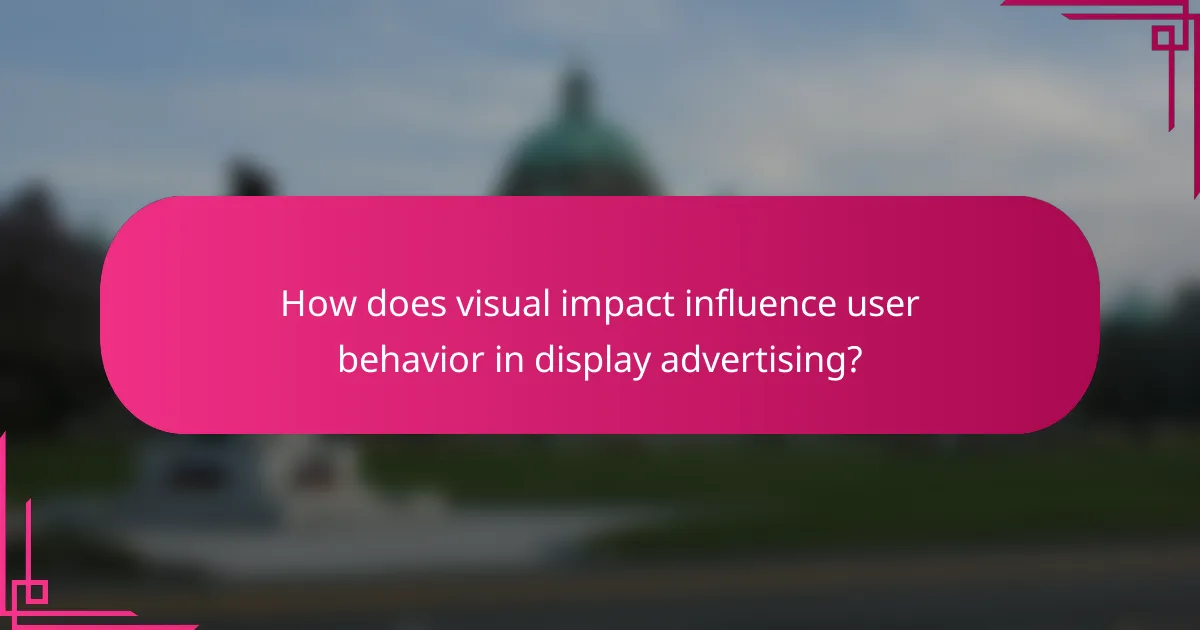Animation techniques play a crucial role in enhancing display advertising by effectively capturing attention and conveying messages. By utilizing dynamic visuals, advertisers can create engaging and memorable ads that resonate with viewers, ultimately driving higher engagement rates and conversions.

How can animation techniques enhance display advertising?
Animation techniques can significantly enhance display advertising by capturing attention and conveying messages more effectively. By incorporating movement and visual dynamics, advertisers can create more engaging and memorable ads that resonate with viewers.
Increased user engagement
Animation draws the viewer’s eye, making ads more likely to be noticed. Interactive elements, such as animated buttons or transitions, can encourage users to click through, leading to higher engagement rates compared to static ads.
For optimal results, consider using subtle animations that enhance rather than distract. Simple effects like fading or sliding can keep the focus on the message while still providing visual interest.
Improved brand recall
Animated ads can improve brand recall by creating memorable visual experiences. Movement can help reinforce brand identity, making it easier for consumers to remember the brand when making purchasing decisions.
To maximize recall, ensure that the animation aligns with your brand’s message and values. Consistent use of colors, logos, and themes in animations can strengthen brand recognition over time.
Enhanced storytelling
Animation allows for dynamic storytelling, enabling brands to convey complex messages in a simplified manner. Through visual narratives, advertisers can illustrate product benefits or brand values effectively, engaging viewers on a deeper level.
When crafting animated stories, focus on clarity and pacing. A well-structured narrative that flows smoothly can maintain viewer interest and enhance understanding of the product or service being advertised.

What are the most effective animation techniques for display ads?
The most effective animation techniques for display ads include GIF animations, HTML5 animations, and video animations. Each technique offers unique advantages in terms of engagement, visual appeal, and compatibility across platforms.
GIF animations
GIF animations are simple, looping images that can capture attention quickly. They are widely supported across various platforms and can convey messages without sound, making them ideal for quick engagement.
When using GIFs, keep file sizes small to ensure fast loading times, ideally under 2 MB. Consider using a maximum of 5-10 frames to maintain smooth playback while keeping the animation concise.
HTML5 animations
HTML5 animations utilize modern web technologies to create interactive and responsive ads. They can include vector graphics, which scale without losing quality, making them suitable for high-resolution displays.
HTML5 allows for more complex animations compared to GIFs, enabling features like user interaction and sound. However, ensure compatibility with older browsers and devices, as some may not fully support HTML5 features.
Video animations
Video animations can deliver rich storytelling and dynamic visuals, making them highly engaging. They can be used for longer messages and are effective in capturing user attention for extended periods.
For display ads, keep videos short, ideally under 30 seconds, to maintain viewer interest. Use clear calls to action and ensure that the video is optimized for various devices and internet speeds to avoid buffering issues.

How does visual impact influence user behavior in display advertising?
Visual impact significantly influences user behavior in display advertising by capturing attention and encouraging interaction. Effective visuals can lead to higher engagement rates, ultimately driving conversions and reducing bounce rates.
Attracts attention
High-quality visuals in display ads are essential for attracting user attention. Bright colors, dynamic animations, and compelling imagery can make an ad stand out in a crowded digital space. For example, ads that incorporate movement or interactive elements are more likely to draw the eye than static images.
To maximize attention, consider using bold typography and contrasting colors that align with your brand identity. A/B testing different visual styles can help identify which elements resonate best with your target audience.
Drives conversions
Visual impact plays a crucial role in driving conversions by creating an emotional connection with users. Ads that tell a story through visuals can evoke feelings that encourage users to take action, such as clicking through to a website or making a purchase. For instance, lifestyle images that showcase a product in use can enhance desirability.
Incorporating clear calls to action within visually appealing ads can further increase conversion rates. Ensure that the message is straightforward and that the design guides the user’s eye toward the action you want them to take.
Reduces bounce rates
Engaging visuals can help reduce bounce rates by keeping users on the page longer. When users find display ads visually appealing, they are more likely to explore the content rather than leaving immediately. This is particularly important for landing pages where the first impression can determine user retention.
To effectively lower bounce rates, ensure that the visual elements of your ads are relevant to the landing page content. Consistency in design and messaging helps create a seamless experience that encourages users to stay and engage with your site.

What are the best practices for creating animated display ads?
To create effective animated display ads, focus on brevity, clarity, and high-quality visuals. These elements enhance user engagement and ensure that your message is communicated effectively within a short time frame.
Keep animations short
Short animations are more likely to capture attention and retain viewer interest. Aim for animations that last between 5 to 15 seconds, as longer durations can lead to viewer disengagement.
Consider using a looped animation that can be viewed multiple times without losing its impact. This approach allows users to absorb the message without feeling overwhelmed.
Focus on clarity
Clarity is essential in animated display ads. Ensure that your message is straightforward and easy to understand at a glance. Use simple language and avoid cluttering the screen with too many elements.
Utilize contrasting colors and legible fonts to make text stand out. This will help viewers quickly grasp the ad’s purpose, even if they only glance at it briefly.
Use high-quality visuals
High-quality visuals are crucial for creating a professional appearance. Use crisp images and smooth animations to convey your brand’s quality and attention to detail.
Incorporate brand colors and logos consistently to enhance recognition. Avoid pixelation or low-resolution graphics, as these can detract from the ad’s effectiveness and credibility.

What metrics should be used to measure the effectiveness of animated ads?
To evaluate the effectiveness of animated ads, key metrics include click-through rate (CTR), conversion rate, and engagement time. These metrics provide insights into user interaction and the overall impact of the ads on the target audience.
Click-through rate (CTR)
Click-through rate (CTR) measures the percentage of users who click on an animated ad compared to the total number of impressions. A higher CTR indicates that the ad is successfully capturing attention and prompting action. Aim for a CTR of around 1-3% for display ads, with animated ads often performing better than static ones.
To improve CTR, ensure that the animation is visually appealing and relevant to the audience. Use clear calls-to-action (CTAs) and test different animation styles to find what resonates best with your target demographic.
Conversion rate
The conversion rate tracks the percentage of users who complete a desired action after interacting with an animated ad, such as making a purchase or signing up for a newsletter. A good conversion rate typically falls between 2-5%, but this can vary based on industry and campaign goals.
To enhance conversion rates, align the ad’s message with the landing page content and ensure a seamless user experience. Consider using A/B testing to compare different animated ads and identify which elements drive the highest conversions.
Engagement time
Engagement time refers to the duration users spend interacting with an animated ad. Longer engagement times can indicate that the ad is captivating and effectively communicating its message. Aim for engagement times in the range of a few seconds to a minute, depending on the complexity of the animation.
To boost engagement time, create animations that tell a story or provide valuable information. Avoid overly complex animations that may confuse viewers, and ensure that the key message is clear and easily digestible within a short timeframe.

What role does user engagement play in display advertising success?
User engagement is crucial for display advertising success as it directly influences how effectively ads capture attention and drive conversions. Higher engagement typically leads to increased brand awareness and customer loyalty, making it essential for advertisers to focus on strategies that enhance user interaction.
Increases brand loyalty
Engaging display advertisements foster a stronger connection between consumers and brands, which can significantly enhance brand loyalty. When users interact with visually appealing and animated ads, they are more likely to remember the brand and its message, leading to repeat purchases.
To increase brand loyalty through display advertising, consider using personalized content that resonates with your target audience. For example, incorporating user-generated content or testimonials can create a sense of community and trust, encouraging users to engage more deeply with the brand.
Additionally, employing interactive elements, such as quizzes or polls, can further enhance user engagement. These techniques not only make the ad experience enjoyable but also provide valuable insights into consumer preferences, allowing brands to tailor their offerings effectively.
